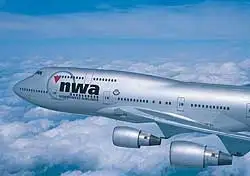
Amidst all the speculation and finger-pointing surrounding the mysterious circumstances of Northwest Flight 188, one question remained: What could cause a pair of pilots to overfly their destination by over 100 miles?
Two words: Blame. Canada.
Well, not exactly. But Canada does figure into the equation. According to CBS News, the pilots accidentally tuned into the wrong frequency—one broadcast from Winnipeg—without realizing it. “American air traffic controllers tried in vain to reach the Northwest flight for 77 minutes. The final communication before the radio blackout was from the Denver air traffic control (ATC) center. But when contact was finally resumed, the pilots turned up on a different frequency, speaking with controllers in Winnipeg, Canada.”
Let’s play this back: The pilots were talking to ATC in Denver. Denver handed them off to the next ATC, but the pilots tuned into the wrong frequency, one in Winnipeg. So while the pilots were unknowingly tuned into the wrong frequency, ATC in Minneapolis had no idea where the pilots were or why they weren’t responsive.
CBS news correspondent Nancy Cordes points out that “pilots have to switch frequencies all the time, so it’s not that unusual that, from time-to-time, a pilot might switch to the wrong frequency. Still, after these pilots hadn’t heard from anyone for about half-an-hour, they should have grown suspicious because, ordinarily, pilots flying over the continental U.S. don’t go, say, ten-to-fifteen minutes without hearing from a controller.
“The fact that they overshot their destination without ever trying to descend indicates that, not only were they not monitoring their radios, but they weren’t monitoring their instruments, as well.”
Or does it?
Over at Salon, Patrick Smith offers his take on the situation, concluding that “the saga of Flight 188 [is] an embarrassing error. But not as scandalous an error, or as reckless an error, as it first appeared.” In short, it’s not so simple as pilots “not monitoring their instruments.” To explain, Smith gives us some behind-the-scenes insight on what likely happened:
“Radio frequencies are at least five digits long (often six digits overseas), and as you might expect, it’s not unheard of for a pilot to accidentally transpose a couple of numbers. This happens from time to time and is seldom if ever dangerous. The situation is normally corrected after a minute or two, often because the incorrect frequency is completely silent: The crew gets no response, and there is no chatter from controllers or other pilots.
“Aboard Flight 188, the first officer mixes up the numbers and dials in a frequency for Winnipeg, Canada, instead of Denver. Let’s call this Factor 1.
“Winnipeg is hundreds of miles away, and controllers there do not hear him. They are unable to acknowledge his call or correct his error. At the same time, however, Flight 188 is at a high enough altitude that transmissions from other aircraft under Winnipeg’s control are clearly audible in the cockpit. Thus there is plenty of chatter coming over the radio. This leads the pilot to believe he is on the correct frequency. Let’s call this Factor 2.”
And it’s all downhill from there. Because the pilots think they’re on the correct frequency, there’s no urgent need to make sure. ATC in Winnipeg likely never responded to the pilots attempt to contact them, but as Smith writes, “failure to get a response from ATC on the first call is not uncommon, especially when a frequency is busy. Occasionally, when the chatter is unusually heavy, you wait for them to contact you.”
“Back on the correct frequency,” Smith writes, “Denver Center is trying to get hold of Flight 188, wondering why it never checked in. They call many times, to no avail. Minutes later, there is a shift change at the facility. For reasons unknown, the new controller is not told about the failure to reach Flight 188. Had he known about this, there are steps he could have taken to help track down the wayward flight. But he didn’t.”
And yes, the pilots’ laptops played a role. At some point they took them out, which they probably shouldn’t have done. But under the circumstances Smith describes, the pilots’ laptop use is hardly the cause for what happened. Instead, it was a series of individually minor errors coming together to create an unlikely outcome. Yes: The entire mess could have been avoided, and the pilots are, in the end, responsible.
But it seems false to boil this incident down to a simple case of neglect or incompentence. If anything, the case of Northwest Flight 188 reminds us just how complex is this business of flying, this marvel of modern technology we’ve come to take for granted, and how much we demand of our inevitably human pilots.
We hand-pick everything we recommend and select items through testing and reviews. Some products are sent to us free of charge with no incentive to offer a favorable review. We offer our unbiased opinions and do not accept compensation to review products. All items are in stock and prices are accurate at the time of publication. If you buy something through our links, we may earn a commission.
Related
Top Fares From
Today's Top Travel Deals
Brought to you by ShermansTravel
France: 8-Night Paris, Avignon & Nice...
Infinity Worldwide Vacations
 vacation
$2880+
vacation
$2880+
Poconos: 3 Nts in Garden of...
ResortsAndLodges.com
 hotel
$305+
hotel
$305+
7-Nt Canada & New England Cruise,...
Princess Cruises
 cruise
$839+
cruise
$839+



